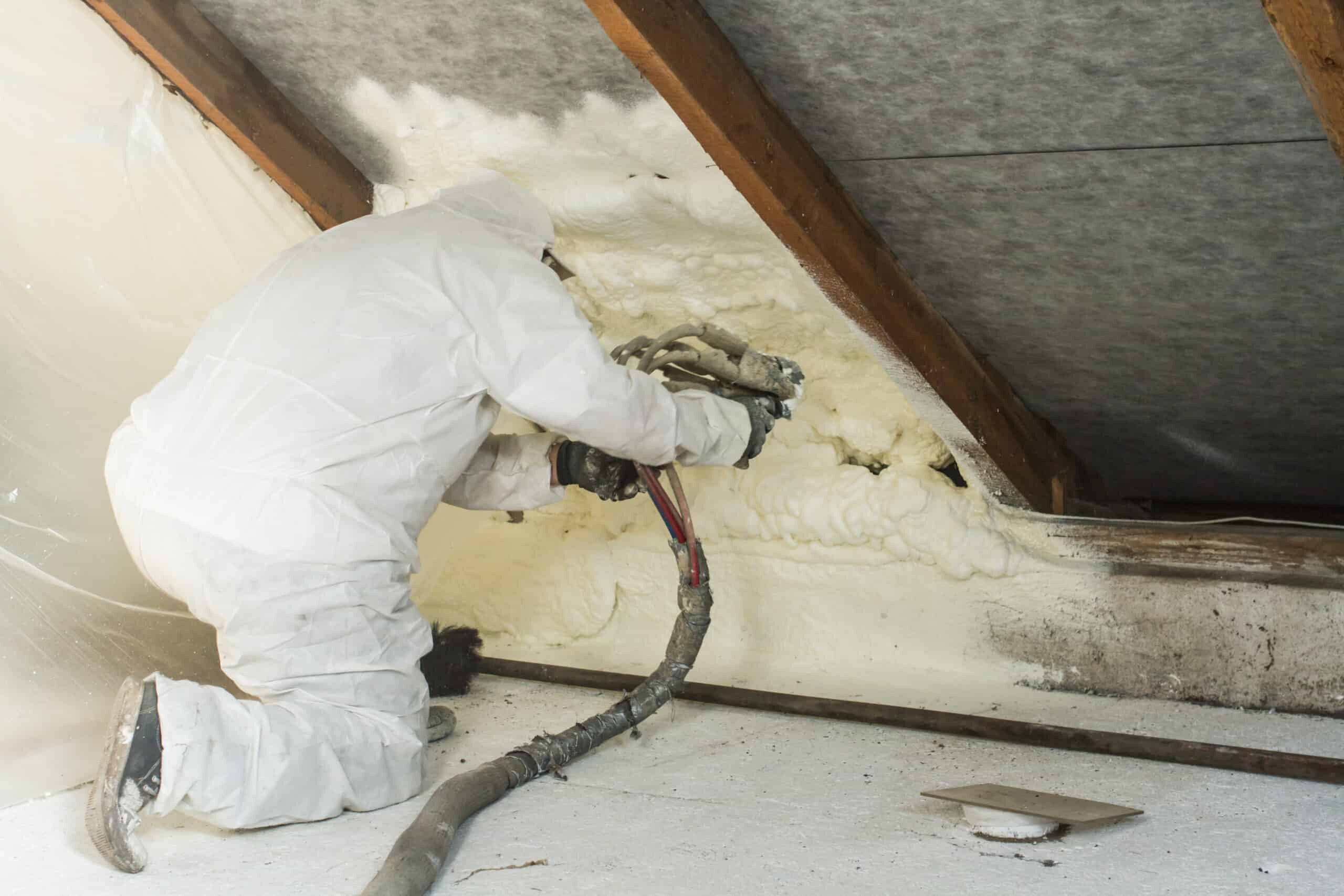Spray foam insulation improves home energy efficiency by tightly sealing air leaks and forming a continuous thermal barrier. Once applied, it expands to fill cracks, crevices, and hard-to-reach cavities that traditional insulation materials often miss. This reduces energy loss, maintains stable indoor temperatures, and significantly lowers heating and cooling demands.
This type of insulation combines air sealing and insulating functions in one material, offering superior performance compared to traditional options like fiberglass or cellulose. With its ability to adapt to various surfaces and reduce energy waste, spray foam insulation is a top choice for homeowners aiming to improve energy efficiency long-term.
How Spray Foam Creates Energy Efficiency
Spray foam works by mixing two chemical components—typically isocyanate and polyol resin—which react upon spraying to form an expanding foam. This foam adheres to surfaces and hardens, creating a durable insulation layer that limits airflow and heat transfer.
Key Energy Efficiency Functions
- Air Sealing: Eliminates gaps and drafts, stopping conditioned air from escaping
- Thermal Resistance: Offers high R-values to slow heat movement through walls, attics, and roofs
- Moisture Control: Reduces risk of condensation that can degrade other insulation types
- Consistent Coverage: Fills irregular spaces traditional batts leave exposed
Bonus Tip
Use spray foam in combination with proper attic ventilation to balance energy savings and indoor air quality
Types of Spray Foam Insulation
Two main categories exist: open-cell and closed-cell spray foam. Each type serves different applications depending on moisture conditions, structural needs, and insulation goals.
Comparison Table: Open-Cell vs. Closed-Cell Spray Foam
| Feature | Open-Cell Foam | Closed-Cell Foam |
| R-Value per Inch | ~3.5 | ~6.0–7.0 |
| Air Barrier | Yes | Yes |
| Moisture Barrier | No | Yes |
| Soundproofing | Excellent | Moderate |
| Application Areas | Interior walls, ceilings | Basements, roofs, exteriors |
| Expansion Rate | High | Low |
| Cost per Square Foot | Lower | Higher |
| Structural Rigidity | Minimal | Adds strength to structure |
| Vapor Permeability | High (breathable) | Low (acts as vapor barrier) |
Bonus Tip
Closed-cell foam can serve as both an insulation and water-resistant barrier, making it ideal for flood-prone or damp environments
Technical Specifications
| Property | Open-Cell Foam | Closed-Cell Foam |
| Typical Thickness Required | 3–5 inches | 2–3 inches |
| Vapor Permeability (perm) | 10+ | ≤1 |
| Density (lb/ft³) | ~0.5 | ~2.0 |
| Application Temperature | 60–80°F | 60–80°F |
| Lifespan | 20+ years | 20+ years |
Installation Process and Application Zones
Spray foam is installed using specialized spray equipment by trained professionals. The foam expands rapidly upon application, filling voids in attics, walls, and crawlspaces. The area must be dry, clean, and within optimal temperature range for effective bonding and curing.
Common Application Areas
- Attics and rooflines
- Crawlspaces and basements
- Rim joists and sill plates
- Wall cavities and vaulted ceilings
- Around windows, doors, and HVAC penetrations
Bonus Tip
In multi-zone homes, prioritize spray foam in attics and basements where air leakage is most common

Energy Impact and Real-World Savings
According to the U.S. Department of Energy, up to 40% of a home’s energy loss is due to air leaks. Spray foam insulation addresses this issue more effectively than any other type of insulation material. By eliminating pathways for heat to escape or enter, spray foam can cut heating and cooling bills by up to 30%.
Market Data Snapshot
- The typical payback period ranges from 3 to 7 years depending on home size, local energy rates, and climate zone
- Homeowners in colder regions report savings of $500 to $1,200 annually after installing closed-cell spray foam in attics and walls
- Homes with continuous spray foam application are 40% more airtight than those with fiberglass or blown-in cellulose
Things to Consider Before Making a Decision
Cost vs. Value
Spray foam costs more per square foot than other insulation types, but it combines multiple functions—thermal insulation, air sealing, and vapor resistance—into one product. The long-term energy savings typically outweigh the initial expense.
Climate Zone
- In cold climates, closed-cell foam provides higher R-values and moisture resistance
- In humid or wet zones, closed-cell helps prevent mold and structural damage
- In mild climates, open-cell may suffice for interior use and sound control
Accessibility of Wall Cavities
Retrofitting an existing home with spray foam can be labor-intensive. While new builds and gut renovations offer easier access, older homes may require drywall removal or alternative access points, increasing project cost and complexity.
Ventilation Needs
Spray foam creates a tight seal, which may reduce natural ventilation. To maintain indoor air quality, mechanical ventilation or heat recovery ventilators (HRVs) may be required.
Code Compliance
Always confirm local building codes regarding minimum R-values, flame spread ratings, and vapor barrier requirements. Some regions require ignition barriers when spray foam is used in exposed locations.
Common Questions
Does spray foam work in all climates?
Yes. Closed-cell is best for cold, wet, or windy climates due to its higher R-value and moisture resistance. Open-cell works well in interior spaces or regions with mild temperatures and low humidity.
Can spray foam be installed in existing homes?
Yes, but it requires access to wall cavities. This may involve removing drywall or using injection methods for open-cell foam in retrofit applications.
How long does spray foam last?
Spray foam is highly durable and maintains its insulating properties for 20 years or more with minimal degradation.
Is spray foam safe after installation?
Yes. Once cured, spray foam is inert and stable. However, proper ventilation during installation is crucial, and no one should occupy the space during application and curing.
Bonus Tip
Ask for low-VOC or GreenGuard-certified foam if you are concerned about indoor air quality post-installation
How Spray Foam Insulation Works to Improve Energy Efficiency in Homes FAQ
How does spray foam improve energy efficiency?
It seals gaps and cracks where conditioned air escapes, reducing heat transfer and lowering energy consumption for HVAC systems.
What’s the difference between open-cell and closed-cell spray foam?
Open-cell is breathable, flexible, and cheaper. Closed-cell is denser, water-resistant, and offers a higher R-value per inch.
Is spray foam better than fiberglass or cellulose?
Yes, in terms of air sealing and long-term performance. Spray foam outperforms both in energy retention but comes at a higher upfront cost.
Can I install spray foam myself?
DIY kits exist but carry risks. Inaccurate mixing or poor ventilation can lead to health hazards or failed insulation. Professional installation is strongly recommended.
How do I decide which spray foam type to use?
Base your choice on location, climate, budget, and desired performance. Closed-cell is ideal for exterior and moisture-prone areas. Open-cell works well in sound-sensitive or interior zones.
Make the Right Decision
spray foam insulation is a powerful solution for improving home energy efficiency. It stops air leakage, provides a strong thermal barrier, and adds structural resilience in some cases. While the initial cost is higher than traditional insulation, the long-term savings on energy bills and maintenance make it a practical investment for many homeowners.
Before choosing spray foam, assess your home’s insulation needs, accessibility, and regional climate. Consult a licensed insulation contractor or building energy auditor to ensure proper installation and compliance with local standards. Choosing the right type of spray foam—open-cell or closed-cell—based on your goals and conditions will ensure the best results.









